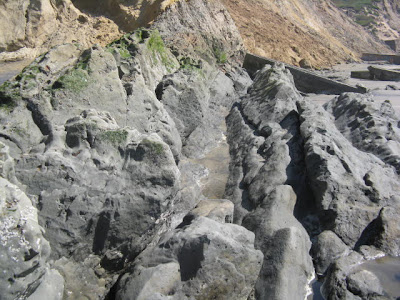
A fierce wind cut in from the north yesterday, sweeping most people off the beaches and into the cafes.

That left the birds in charge of the place.

This coastal area will be submerged over the coming decades as climate change raises the sea level.

Knowing that makes visiting it even more special than would otherwise be the case.

I've been visiting Ocean Beach for 38 years. All of my children and partners have been there with me. Everyone has helped build our substantial family seaglass collection.

It's probably just an old man's nostalgia, but I regret that my children will not have this place to visit in the decades after I pass on. My grandchildren may never even get to see it, unless we take them there in the next 10 or 15 years. (They do not live in the Bay Area, so that may or may not happen.)
Anticipating these changes, I am devoting this particular post to some memories and observations. The photos provide a bit of mood, but sadly I do not have a multimedia presentation to offer. Because, on a day like yesterday, the ocean was so riled up by winds and off-shore storms that it roared constantly, not in the gentle rhymes of a quieter day but with the violent anger of a bull sea lion.
Hours after returning home, I could still feel that roar pulsating in my ear drums, as well as the itch of the sand that had dusted my ears, hair, mouth and whiskers. As my visit occurred at low tide, the beach itself was wide, gently sloping down to the tideline, where thin layers of water washed over thin layers of water, pushed by the wind up toward the beach but unable to overcome the tidal pull back to sea.
Left naked to view were several large jellyfish-like creatures -- clear piles of tissue with colorful tubes and channels, organs, and food, visible within. It was like glimpsing one of those transparencies of living creatures that leaves you slightly queasy, but strangely addictive nevertheless.
Also left for the few finders about were sand dollars, pristine, unbroken, of all shapes and sizes. One was no larger than a thumbnail, a baby sand dollar, all white, and therefore dead. (When alive, they are a purplish green color, with hairy underbellies that probably allow them to migrate about.)
Besides my precious cache of seaglass, there were stones of every size, shape, color, and pattern, some of which I simply had to bring home with me, because they were way too beautiful to leave for an unclaimed future.
What there was very little of, thankfully, was human trash.
The clay flows along this beach are one of its most remarkable features. Thanks to the clay, there are thousands of fossils of sea creatures from times past. The clay itself mixes uneasily with the sand to melt -- I can't think of a more descriptive word -- into exotic patterns that yield rivers of subtle browns, grays, and yellows flowing toward the lashing saltwater nearby, waiting to devour these and every other land-based element once it is released by the moon's sway.
Yesterday, probably due to the vicious winds, which create instant sand dunes and down power lines and traffic lights, much of the Great Highway that borders the beach was closed to traffic.
With the beach and highway so empty and bereft of people and their vehicles, it was all too easy to imagine the future of this treasured place. Everything I've described will be under the sea, but birds will still hunt these shores. Underneath the ocean, the clay will still leak and lurch, creating its lovely patterns now on the sea bottom, far from our view.
Perhaps, in a distant future, long after I and mine have departed, the climate will pivot once again. Perhaps someday, someone, maybe even a great-great-great grandchild, will rediscover this place anew, as the seas retreat, and the beauty of a long-forgotten paradise once again presents itself to human view, beckoning a wanderer.
If so, I hope that boy or girl feels a shiver of familiarity as the shiny pieces of seaglass that will no doubt survive any coming calamity slowly reveal themselves once again, whispering with sultry desire: "Look at me."

-30-
2 comments:
Great post, David. Yeah, change is happening. But a couple of observations--not arguments!--I'd make:
1. Think of the incredible change worked on this landscape by what we've done in the last 150 years. The California that existed then is no more; and it's plausible that the one that one of our grandparents might have ruminated on has also passed. I don't know whether the change to come is on a greater scale than these changes or not. But I suppose the point is to learn from them. I'd love to see some wild chinook be among the first beneficiaries of our enlightenment, though I ain't holdin' my breath.
2. The wonder you have for the land and this scene is partly inspired by the world you behold and partly generated by some force, some vision, some love for life and this place we live that comes from entirely within you. So we have a bittersweet prospect, you and I: the places we love are changing in a way that may put them beyond our children and grandchildren; yet we can pass on our love and our ethic, and they will love what they see, too, and be inspired to try to embrace it and save it.
Here's hoping, anyway.
Thank you, Dan, one my true compatriots in this journey. I suspect we both write as we do out of a common purpose.
Post a Comment